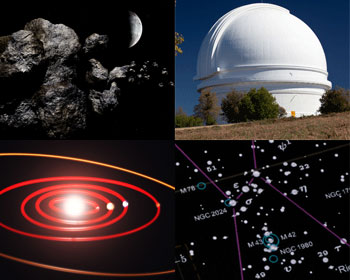A Publication of the
Applied Math and Science Education Repository

The AMSER Science Reader Monthly aims to provide educators with a useful package of information about a particular topic related to applied math and science by combining freely available articles from popular journals with curriculum, learning objects, and web sites from the AMSER portal. The AMSER Science Reader Monthly is free to use in the classroom and educators are encouraged to contact AMSER with suggestions for upcoming issues or comments and concerns at [email protected].
This month's AMSER Science Reader Monthly topic is Astronomy.
On the Fringe: Astronomers look to the Kuiper belt for clues to the solar system's history
Article by Ron Cowen of Science News
Synopsis and resource annotations by Max Grinnell

Far beyond the realm of Neptune sits the Kuiper belt, a fascinating relic of frozen, icy debris that has intrigued astronomers for decades. It was named for Gerard Kuiper, who predicted the existence of this three billion kilometer-wide swath of miscellanea and detritus in 1951. The Kuiper belt contains many curious items, including Pluto, which was reclassified as a minor planet in 2006.
This engaging article by Ron Cowen appeared in the January 16, 2010 edition of Science News, and it takes a close look at recent investigations into the Kuiper belt by astronomers around the world. The piece starts by reviewing recent work discussed at the annual meeting of the American Astronomical Society's Division for Planetary Sciences, which took place last October in Puerto Rico.
An important feature of the Kuiper belt is that many of the objects within the belt have wildly elliptical orbits and move on paths of significantly higher inclination than those that more closely follow the planets that orbit the sun. Astronomers are intimately interested in these paths, and many of those astronomers, including Hal Levison of the Southwest Research Institute, believe that these paths suggest a "close and violent encounter" with at least one of the outer planets.
The evidence of this encounter is also being used by astronomers to learn more about the early solar system. It remains to be seen exactly which one of the outer planets might have been responsible for an encounter, but a number of people, including Mike Brown of Caltech, suspect that it may have been Neptune. Work into how and when Neptune made its move into the Kuiper belt could potentially help astronomers explain how and when the planets assumed their final positions in the solar system.
The article concludes by talking a bit about the sky survey called Pan-STARRS, an attempt to count and document all objects in the Kuiper belt. This multi-year survey will be able to find items in the belt as small as about 250 kilometers across. The hope is that the survey will also help determine which objects' orbits were altered by an early interaction with the outer planets.
Found below is a list of useful resources that will illuminate and enhance understanding of the topics found within this article. The first link will take users to a NASA website that provides helpful images and articles that illuminate the nature of the Kuiper belt. The second link leads to an excellent website that contains information about the New Horizons spacecraft, which is set to visit both Pluto and the Kuiper belt in 2015. Moving on, the third link leads to a "how-to" activity which helps users build their own scale model of the solar system. The fourth link leads to the homepage of the Stanford SOLAR Center. Here educators can take advantage of lesson plans such as "Effects of the Sun on Our Planet" and "Build a Spectroscope". The fifth link will whisk users away to the homepage of the Solar System Exploration website, provided by NASA. Visitors to this website can take advantage of news coverage of space science events and an interactive timeline of robotic exploration of space. The last link leads to the National Space Science Data Center website, which contains fact sheets, images, and interactive lesson plans regarding the world of the solar system.




